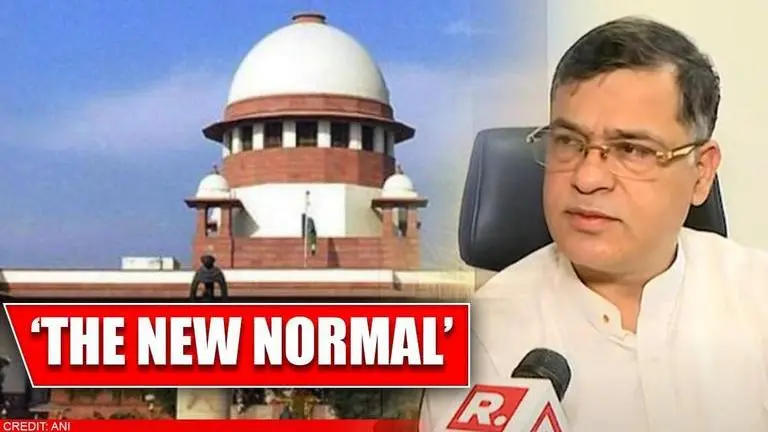Updated 11 June 2020 at 12:40 IST
Access to Justice in Supreme Court ensured by VC hearings, writes Sr Adv Sidharth Luthra
About two months after the lockdown began, the Supreme Court which started Virtual Courts has now taken a decision to continue with virtual hearings
- Opinion News
- 5 min read

About two months after the lockdown began, the Supreme Court which started Virtual Courts almost immediately to overcome the restrictions on movement, has now taken a decision to continue with virtual hearings and not to reopen Court for hearings with physical presence of lawyers/ litigants.
The Supreme Court Bar Association (SCBA), Supreme Court Advocate on Record Association (SCAORA) and the Chairman, Bar Council of India, who represent the legal community, had been pressing the court to reopen for physical hearings. But in the absence of a cure for COVID-19 and with no vaccine in sight, the Supreme Court took the difficult but pragmatic decision to continue only with Virtual Court hearings for the present.
In March and early April this year, initial days of the lockdown, the Vidyo app to provide access to hearing of cases at the Supreme Court became operational. There were some initial technological limitations, but were resolved on the spot using normal telephones or whataspp communication. From mid-April 2020, the case-load handled daily by each Bench has increased.
Currently each bench is hearing more than 20 matters daily, with some detailed hearings taking hours. The enhancement of infrastructure and the 24x7 effort of the Court’s Registry officials has ensured greater access to Virtual courts, with the quality of hearing close enough to actual courts. The Virtual lobby enables lawyers waiting for their matters to observe all hearings in cases, irrespective of whether they are appearing in those matters or not. Journalists have access to hearings and the open court principle which is essential to the rule of law is being followed.
Under the Advocates Act, 1961, the State Bar Councils as well as the Bar Council of India have to safeguard the rights and interests of the advocates and to promote law reforms. The Bar Associations and the Bar Council of India, whose efforts for a return to physical hearings have now failed, missed seeing the writing on the wall and ought to have used this time to create access for lawyers to Court. Since May 2020, these bodies had the opportunity to create facilities for safe and sanitized appearance of their members who do not have access to computers and phones.
Advertisement
The feasibility of arranging well-equipped VC facilities both within and outside the Supreme Court complex, exists. It was for the Bar Associations and the Bar Council to ramp up electronic infrastructure to support lawyers outside the Supreme Court complex and chamber blocks. Locations where virtual court facilities can be created to ease access to lawyers are places with a high concentration of lawyers, such as the Supreme Co-operative Apartments on the Noida Expressway and in Mayur Vihar or even at Neeti Bagh. The Delhi High Court Online Hearing Rules of 2020 show the process and feasibility of creating locations within Delhi and NCR to create remote access to courts.
Though some Courts and tribunals have recently opted for reopening their doors for physical court appearances, we cannot lose sight of how the Supreme Court is constructed with limited points of access due to security concerns. To begin physical court appearances would endanger the health, lives and safety of those lawyers who attend Courts and also endanger the lives and safety of their families, and of their chamber staff. Lawyers who have elders or young children at home, and lawyers above 65 years of age or those who have comorbidities cannot be exposed to public places at this stage. The restarting of physical courts would limit their ability to represent their clients.
Advertisement
While the Bar Associations had sought to raise certain concerns of a section of the Bar, the Court has responded to the health concerns of others (lawyers), as also of the litigating public, for keeping physical access to Court restricted. For those of us (lawyers) used to working with physical files and papers, it is a process of learning new skills. It is also time to recall skills that we gained at the beginning of our professional careers when we filled the role of a clerk and a lawyer, handling matters from start to finish, ourselves.
This decision of the Supreme Court shall hopefully be replicated by other courts. The implications of a possible spread of infection within the Bar or to Judges can lead to catastrophic consequences for the Justice delivery system. The Bar Councils across India can and should set-up and train Advocates on virtual court hearings and provide advocates updated technological tools and thus ensure that the justice delivery system continues to function. We have come a long way from the steps that were taken initially in the lockdown.
Delivery of justice – expeditious, open and fair – through virtual hearings is the new normal. While VC has time constraints and may not achieve efficiency levels of physical Courts immediately, there is no constraints of distance and today the Supreme Court is far more accessible than ever before to lawyers and litigants in India and overseas. Consequently some lawyers may not return to their ample pre-COVID caseloads, but that is a professional reality they will have to learn to adjust to in a changed world.
(The author, Sidharth Luthra, is a Senior Advocate of the Supreme Court of India. He has served as Additional Solicitor General (ASG) of India and practises in the Supreme Court and Delhi High Court.)
Published By : Digital Desk
Published On: 11 June 2020 at 12:21 IST
